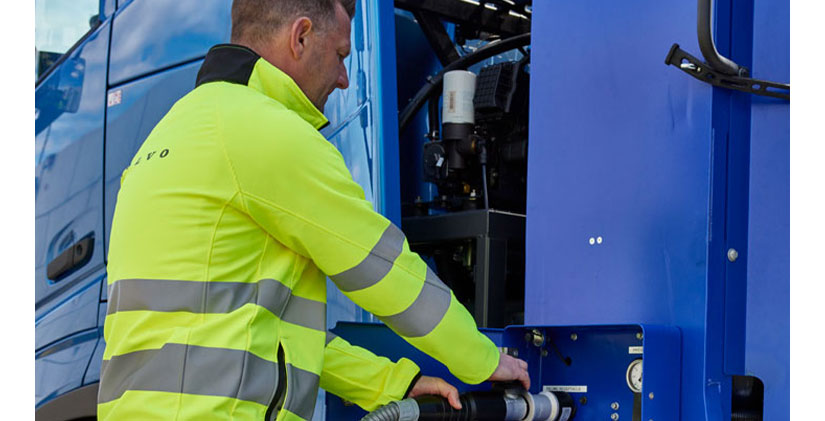Hydrogen fuel cells and
combustion engines
Green hydrogen is a potential paradigm shifter that can play a major role alongside battery electrification and other renewable fuels in creating the carbon-neutral societies of tomorrow. Learn about our approach to using green hydrogen in a range of new propulsion systems currently in testing.
Green hydrogen as fuel at Volvo Group
Fuel cell and engine technologies that are practical for use in commercial transport systems and infrastructure are now accelerating, and we anticipate the roll out of hydrogen production and refueling infrastructure to speed up in the coming years. Hydrogen fuel cells and engines used in commercial vehicles and machines will be an essential element for the future of transportation and infrastructure. Hydrogen fuel cells represents a clear focus for us alongside battery electric vehicles and renewable fuels (such as green hydrogen, bigoas and HVO) in the combustion engine. This is what we call our three-pronged approach to decarbonization.
Hydrogen fuel cells
Fuel cell electric vehicles (FCEVs)
Fuel cell electric vehicles (FCEVs) use a hydrogen fuel cell to power an electric motor. Instead of storing energy in a battery, FCEVs store hydrogen gas in tanks and convert the gas into electricity using a fuel cell and a smaller battery for energy recovery and acceleration support. This process is efficient and clean, with water vapor being the only emission. FCEVs can be refueled quickly, much like conventional vehicles, and offer a longer range than most battery electric vehicles (BEVs).
Efficiency of hydrogen fuel cells
Hydrogen fuel cells are an efficient power source for trucks, construction equipment buses and industrial or marine applications, as they benefit from a high energy-to-weight ratio. Unlike batteries, which add weight and require longer recharge times, fuel cells can power heavy loads over longer distances and be refueled quickly. This efficiency is a major advantage for long haul trucking, where minimizing downtime is crucial.
Hydrogen fuel cells and trucks
At Volvo Group we see hydrogen fuel cells as one of the key enablers of fossil-free transportation systems, supporting our transition to net-zero greenhouse gas emissions. Through the use of hydrogen in both fuel cell and combustion applications, we believe that we can offer a competitive long-term balance of power, flexibility, and range, with the benefit of zero emissions.Both hydrogen fuel cell technology and hydrogen powered combustion engines will be needed to decarbonize commerci al transports.
How do hydrogen fuel cells work?
Hydrogen fuel cells generate electricity through a chemical reaction between hydrogen and oxygen. In a fuel cell, hydrogen gas is fed into the anode where a catalyst causes the hydrogen molecules to split into protons and electrons. The protons pass directly through a membrane to form water, which is the only by-product in this process. The electrons create a separate current that can be used before they return to the cathode to be recombined with oxygen and protons.
Off-road, marine and industrial applications
We see hydrogen fuel cells as one vital element in powering construction equipment, like our articulated hauler HX04 prototype and other such applications in the coming years. As with hydrogen fuel cell powered trucks, such applications will also rely on the availability of local or onsite hydrogen generation and refueling infrastructure.
Commercializing green hydrogen:
the challenges and opportunities
Clearer energy policies and cross-sector collaboration
Many countries around the world now have ambitious hydrogen strategies and hydrogen plays an essential role in the EU Green Deal. There is a great willingness to engage in cross-sector hydrogen usage and the industries are actively looking for potential synergies with, for example, trucks and construction equipment hydrogen usage.
However, there is a need for a certificate of origin system for hydrogen. This to be able to trace that climate friendly hydrogen has been used and thereby resulting in fulfillment of low emission. This can be used as a basis for the level of taxation. Volvo Group would encourage a CO2 declaration on hydrogen rather than talking about colors.
Development of infrastructure to support the transition
National and local governments, the industry, and investors will need to band together to develop the necessary infrastructure to support the energy transition to Green hydrogen and make it commercially viable. There are several hurdles we need to cross, for example the lack of infrastructure and hydrogen prices for end-users.
The biggest problem today is that new offtakes (users) are not yet present. There is a huge willingness to invest, but not without the assurance of customers. Trucks are seen as a practical level to practice upon before going really big scale, such as the cement industry.
Governments and industries need to work together
Governments and industries need to work together to ensure that both existing and new regulations won’t impede investment in Green hydrogen. The trade of hydrogen will benefit from a common international standard for both transporting and storing large quantities, and for tracking the environmental impacts different hydrogen supplies might have.
